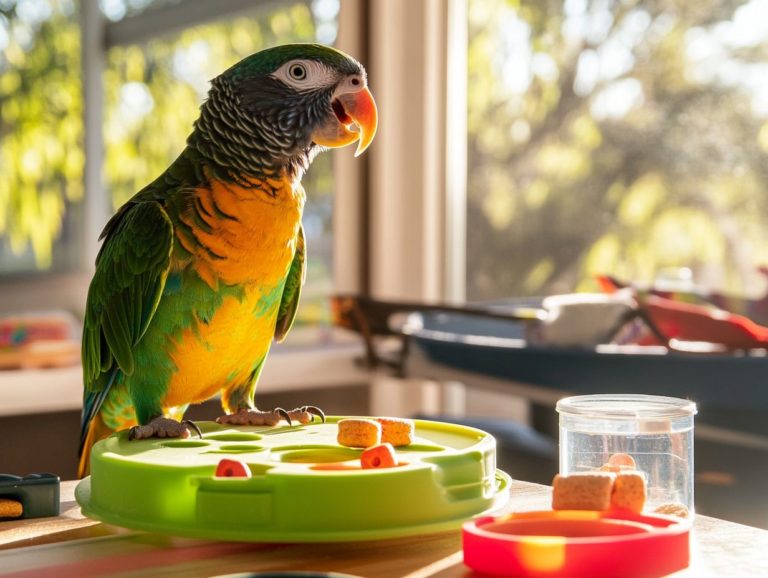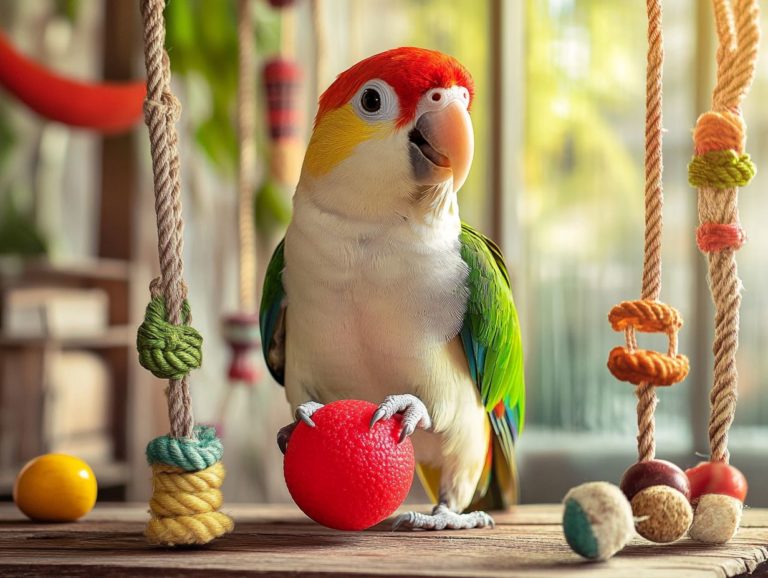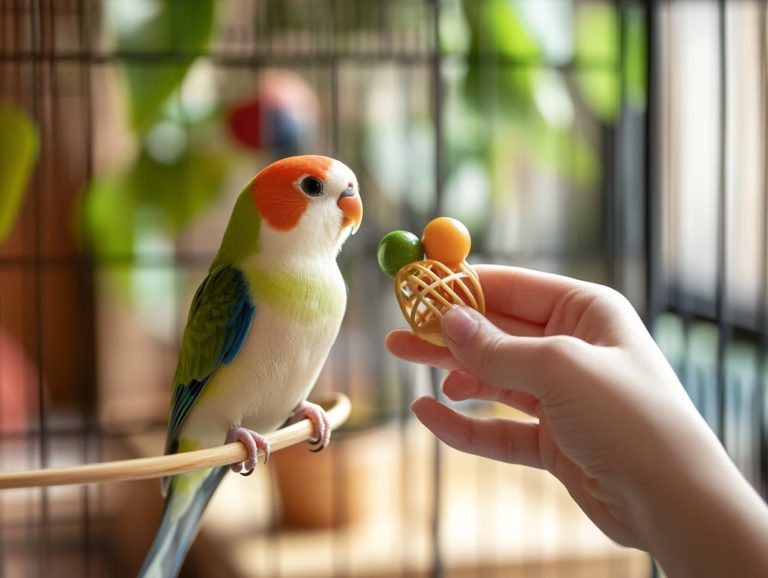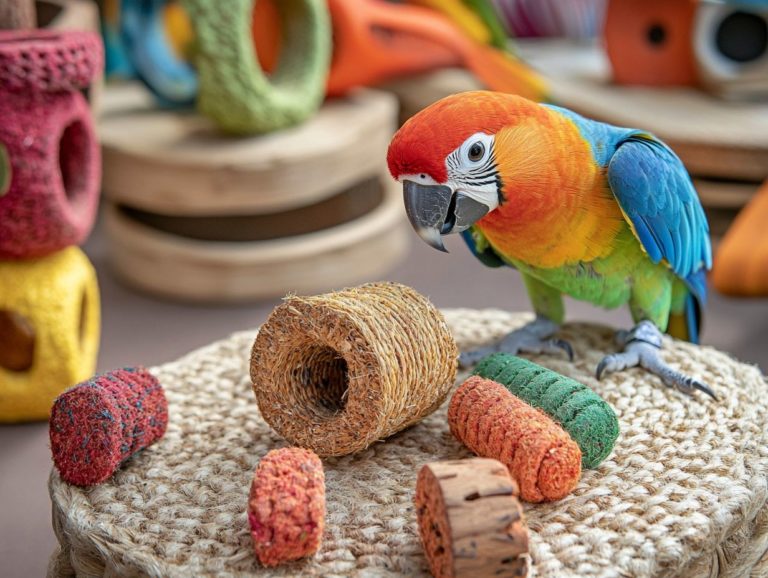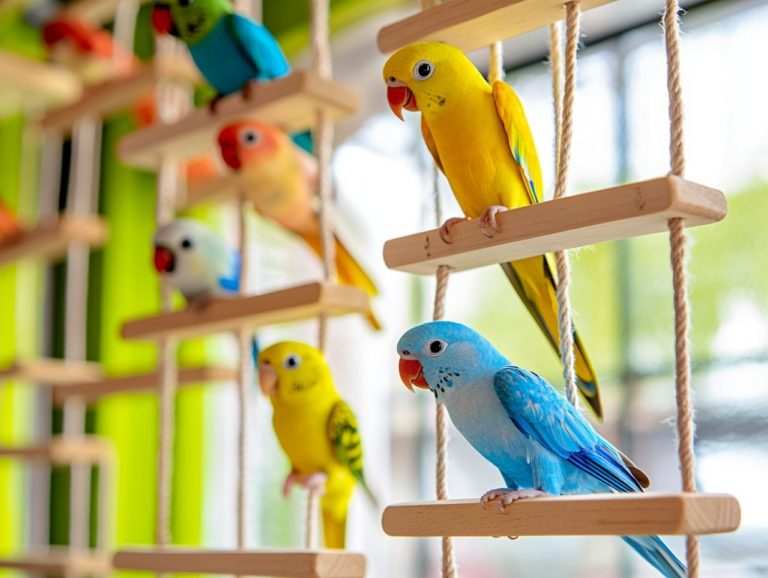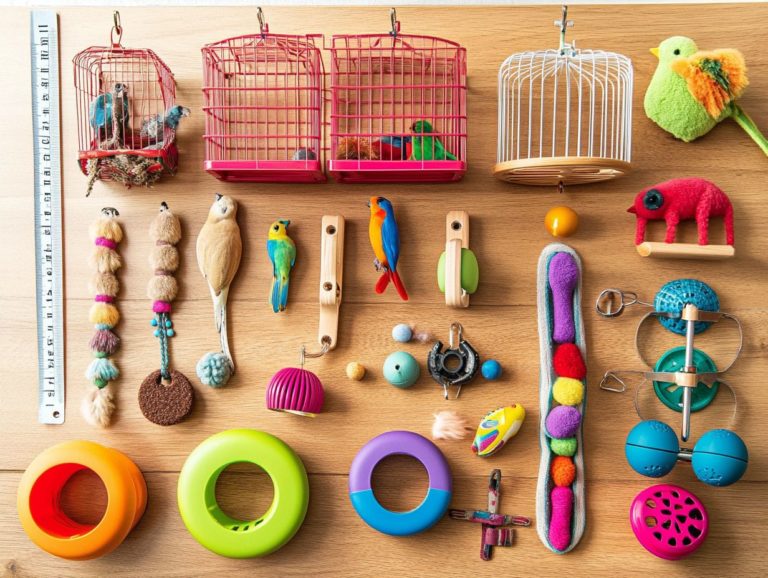Creating a Bird-Friendly Living Space
Creating a bird-friendly living space transcends mere aesthetics; it cultivates a vibrant ecosystem right in your backyard. Birds are essential players in our environment, contributing to everything from pollinating plants to managing pest populations.
This guide emphasizes the significance of designing your space to welcome these feathered companions, showcasing the best native plants, optimal food and water sources, and safe nesting areas. By attracting birds, you not only enhance your well-being but also make a positive impact on the planet.
Contents
- Key Takeaways:
- Understanding Bird-Friendly Living Spaces
- Designing Your Space for Birds
- Providing Food and Water Sources
- Creating Nesting Areas
- Attracting and Maintaining Bird Visitors
- Benefits of a Bird-Friendly Living Space
- Frequently Asked Questions
- Want to make your home a bird paradise? Here are some great tips!
- Why is it important to create a bird-friendly living space?
- How can I attract specific types of birds to my living space?
- What types of plants are best for creating a bird-friendly living space?
- What are some other ways to make my living space welcoming to birds?
- How can I ensure my living space remains bird-friendly long-term?
Key Takeaways:
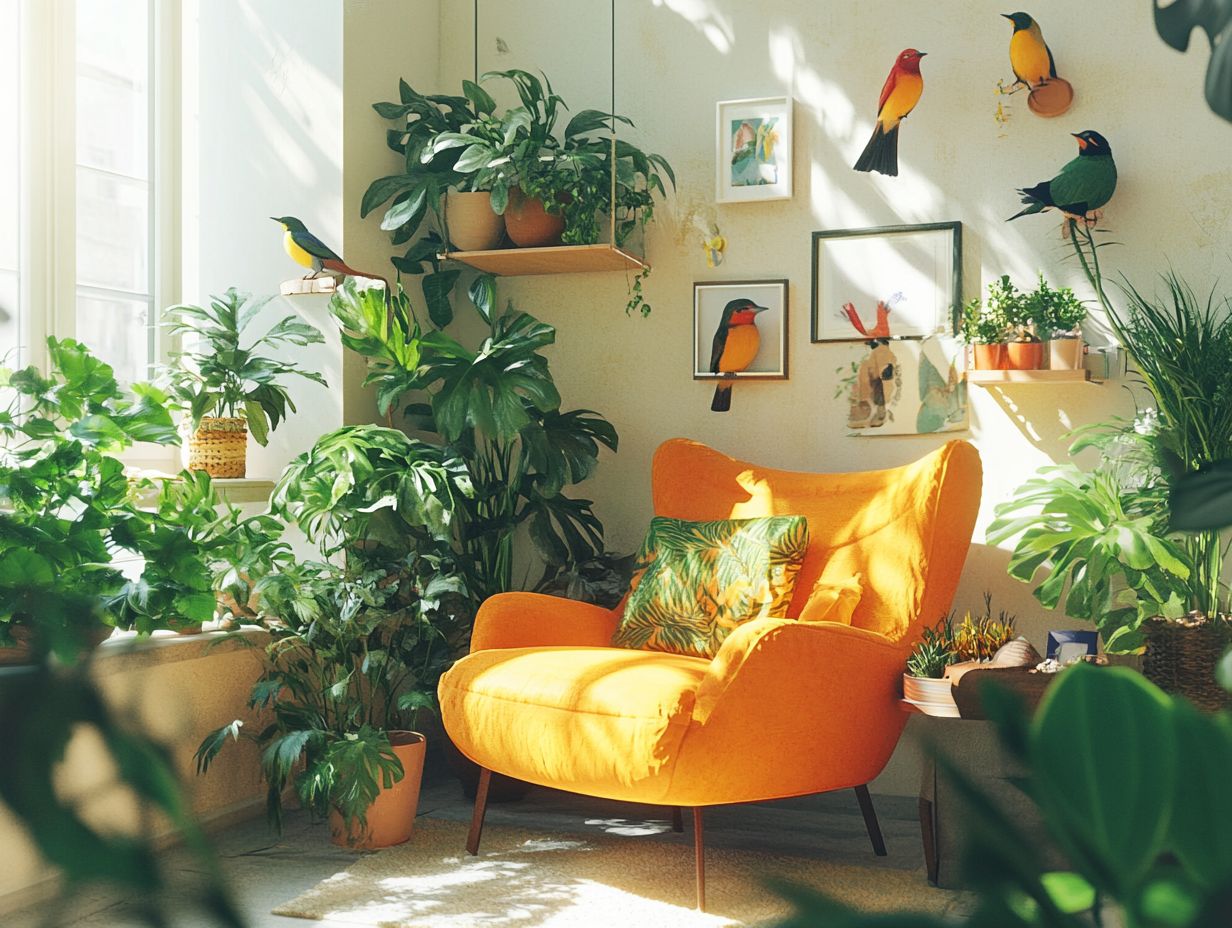
- A bird-friendly living space benefits both the environment and you, bringing a sense of joy and well-being.
- Designing your space with native plants, food and water sources, and nesting areas can attract and maintain bird visitors.
- Creating a safe and welcoming environment for birds is important for their survival and the overall health of the ecosystem.
Understanding Bird-Friendly Living Spaces
Creating bird-friendly living spaces is essential for promoting the variety of different species in a particular place and supporting local wildlife, including cherished species like the Northern Cardinal and Yellow Warbler.
A thoughtfully designed habitat can turn your backyard into a sanctuary, nurturing birds while enhancing community engagement and contributing to ecological conservation.
By incorporating native plants and sustainable gardening practices, you can attract a diverse array of bird species, effectively addressing habitat loss and ensuring their safety from predators and window collisions. You should also consider the challenges posed by light pollution (excess artificial light disrupting ecosystems).
Understanding these principles is crucial for fostering a joyful and responsible relationship with our avian friends. This enriches both your life and the environment in the process.
Why is it Important?
Understanding the significance of creating a safe outdoor space for your bird is essential for addressing habitat loss and bolstering wildlife conservation efforts within your community.
As urban development spreads and natural habitats shrink, many bird species struggle to adapt to this shifting landscape. This not only jeopardizes their survival but also disrupts the broader ecosystem.
By cultivating spaces that meet their needs like native plant gardens and inviting birdhouses you can make a substantial contribution to local biodiversity. These efforts resonate with the missions of conservation organizations such as Audubon, dedicated to safeguarding birds and their habitats.
Involving your community in conservation activities instills a collective sense of responsibility. This can inspire individuals to appreciate and protect the natural world that surrounds them.
Designing Your Space for Birds
Designing your outdoor space with birds in mind means thoughtfully incorporating native plants, strategic bird feeders, and secure nesting areas. This approach not only creates an inviting habitat but also nurtures local wildlife, allowing you to foster a vibrant ecosystem right in your backyard.
Choosing Native Plants and Trees
Selecting native plants and trees is a crucial step in crafting a healthy and sustainable habitat for birds. These plants provide the essential food and shelter that local species rely on.
By incorporating native flora into your gardens and landscapes, you can significantly contribute to the local ecosystem.
These plants are adapted to your region’s climate and soil, requiring less water and maintenance while naturally supporting the food web.
Many bird species thrive on the seeds, berries, and nectar produced by native plants, fostering rich biodiversity. Resources like native plant databases can help you identify the right species for your area.
You can also use popular gardening techniques like companion planting (planting different crops together for mutual benefits) and creating wildlife corridors to further enhance these habitats.
This approach not only benefits birds but also promotes a flourishing environment for pollinators and beneficial insects, transforming urban areas into more vibrant and ecologically balanced spaces.
Providing Food and Water Sources

Providing food and water sources, like bird feeders and clean drinking water, is essential for attracting birds to your backyard and meeting their nutritional needs.
Different types of bird feeders think mesh feeders for small seeds, tube feeders for sunflower seeds, and platform feeders for various species create a welcoming environment for our feathered friends. By adding mealworms, suet (a high-fat bird food made from animal fat), or nectar to these feeders, you can entice a diverse range of birds, from vibrant hummingbirds to cheerful warblers.
Establishing fresh water sources significantly enhances their habitat and encourages visits from both common and rare bird species. Consistent cleanliness and responsible maintenance will ensure that these resources contribute to the overall health of the avian population, fostering a thriving ecosystem right in your garden.
Creating Nesting Areas
Creating safe nesting areas, such as birdhouses and brush piles, is essential for supporting bird populations and encouraging their return to your outdoor space, especially in urban areas.
To achieve this, think about the size of the birds and the size of the entrance hole. This is crucial for attracting the right species. Construct birdhouses that cater to the specific needs of various species. Using natural materials like untreated wood can help mimic their natural environment, making your offerings more inviting. Adding nesting materials such as twigs, leaves, and feathers will entice birds to settle in and make themselves at home.
It s also crucial to position these shelters strategically, away from dense foliage, to minimize the risk of predators. Ensuring they are sheltered from harsh weather provides a secure refuge for your feathered friends, encouraging them to thrive in your outdoor haven.
Attracting and Maintaining Bird Visitors
Attracting and retaining bird visitors in your backyard involves understanding their behaviors, providing the right resources, and implementing effective ecological practices tailored to your local environment.
By diving into their preferences, you can create a sanctuary that not only draws them in but also keeps them coming back.
Tips for Attracting Birds
To truly attract birds to your backyard, consider implementing strategies such as placing bird feeders in prominent locations and incorporating native plants that naturally provide food sources.
By positioning feeders near natural cover like shrubs or trees you offer birds a safe landing zone and encourage them to visit more frequently. Different types of bird food, including seeds, suet, and nectar, cater to a range of species; for instance, finches particularly enjoy sunflower seeds, while hummingbirds are irresistibly drawn to sugar-water solutions.
Planting native species does more than provide food; it also offers essential shelter and nesting materials, creating a more inviting habitat. Together, these practices cultivate a thriving avian community, enhancing your birdwatching joy in your outdoor space.
Keeping Your Space Safe for Birds
Ensuring the safety of birds in your outdoor space is paramount. Minimize risks like collisions with windows and keep cats indoors to protect vulnerable wildlife.
Using window treatments like screens, films, or decals can significantly reduce the chances of these beautiful creatures hitting glass surfaces. Responsible pet ownership is also vital; by keeping cats indoors, you safeguard local bird populations and enhance your feline’s health.
Community awareness plays a key role in these conservation efforts. Neighbors can come together to share valuable information, organize workshops, and promote local initiatives aimed at creating bird-friendly environments.
When communities unite to raise awareness, they cultivate a culture of respect for wildlife, encouraging more individuals to adopt practices that protect our feathered friends while reducing threats like cats roaming freely.
Benefits of a Bird-Friendly Living Space

Creating a bird-friendly backyard is a fantastic way to boost our environment and connect with nature! Not only does it enhance biodiversity, but it also brings joy to your community through the delightful experience of wildlife observation.
Environmental Impact
The environmental impact of bird-friendly living spaces is remarkable. These habitats play a vital role in conserving biodiversity and nurturing local ecosystems, especially when you know how to create a calm space for your bird.
By creating essential shelters, nesting opportunities, and food sources, you support bird populations crucial for pollination, seed dispersal, and pest control. Urban bird habitats also combat the adverse effects of climate change, enhancing green spaces, improving air quality, and reducing urban heat levels.
These environments foster a deeper connection between communities and nature, promoting stewardship and raising awareness of ecological challenges. Ultimately, cultivating bird-friendly areas enriches your quality of life and creates vibrant habitats that elevate the entire community.
Personal Enjoyment and Well-Being
Engaging with birds in your backyard not only brings you joy but also enhances your personal well-being. It creates a connection to nature that enriches your life and the community around you.
The simple act of observing these magnificent creatures can evoke feelings of tranquility and excitement. It allows you to escape from daily stressors while cultivating mindfulness.
As you watch the birds flit about, you might find yourself feeling more grounded and appreciative of your surroundings. This shared passion can unite you with others, sparking conversations and fostering friendships among neighbors.
These newfound connections can lead to collective actions, such as volunteering for local conservation projects. This deepens your sense of purpose and commitment to protecting wildlife for future generations.
Frequently Asked Questions
Want to make your home a bird paradise? Here are some great tips!
Some ways to create a bird-friendly garden include providing a variety of plants for food and shelter, installing bird feeders and birdbaths, and minimizing the use of pesticides and herbicides.
Why is it important to create a bird-friendly living space?

Creating a bird-friendly living space supports and promotes the well-being and survival of birds, which are vital to a healthy ecosystem.
How can I attract specific types of birds to my living space?
You can attract specific types of birds by researching their preferred habitats, food sources, and nesting preferences, then incorporating those elements into your living space.
What types of plants are best for creating a bird-friendly living space?
The best plants for creating a bird-friendly living space are native plants that provide food and shelter for birds, such as berry bushes, nectar-producing flowers, and trees with dense foliage. Additionally, consider exploring how to create a cozy bird nesting area to further enhance their habitat.
What are some other ways to make my living space welcoming to birds?
In addition to providing food, water, and shelter, make your living space welcoming by avoiding reflective surfaces that can confuse or harm them. For more tips, check out how to create a calming environment for birds. Keep pets indoors or supervised to prevent them from disturbing or attacking birds.
How can I ensure my living space remains bird-friendly long-term?
You can ensure your living space remains bird-friendly by regularly maintaining bird feeders and baths, monitoring the health of your plants, and avoiding harmful chemicals. Additionally, consider incorporating bird accessories that promote well-being. Stay informed about bird conservation efforts and advocate for policies that support bird populations.
Start creating your bird-friendly space today and witness the joy it brings!

